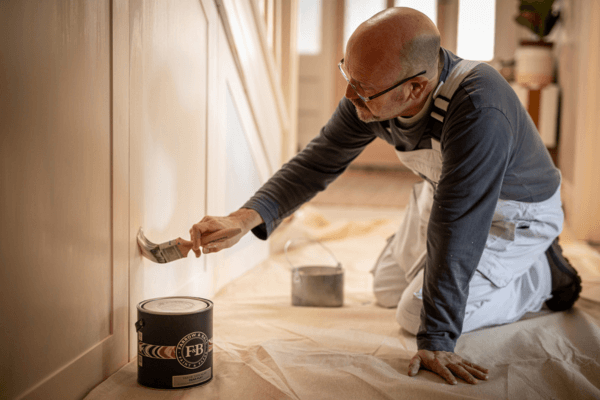PCA Articles

Tips for the Trade: How to Create a Flawless Finish with Farrow & Ball
We’re renowned for our rich colours, iconic finishes and an extraordinary response to light — the way our paint evolves with its surrounding. To help you make the most of our handcrafted paint, we’ve put together a guide on preparation, application and troubleshooting.
Preparation
First things first, always read the Product Advice Sheet for your chosen finish. You’ll find everything from dilution advice to spraying guidelines. It’s also important to wait until the conditions are right for painting: not too hot, too cold or too humid.
Before picking up a paintbrush, make sure your surface is clean, dry and sound. Previously painted walls should be cleaned and degreased with a diluted sugar soap solution to remove contaminants, then washed off with clean water and left to dry. If you’re painting brand-new plaster walls, make sure they’re dust free and clean.
Application
We always recommend following the Farrow & Ball system: one coat of the correct Primer & Undercoat followed by two of topcoat. This evens out underlying imperfections, makes application easier and creates a more durable, colour-rich finish.
If you’re doing a very significant colour change or if your first coat appears patchy, you may want an additional coat of Primer & Undercoat. In general, thorough preparation and a solid basecoat create a better finish (and so, is faster) than trying to add more topcoats. If you’re using more than one tin of topcoat, decant and mix them to minimize any chance of minor differences between batches.
It’s tempting to speed up the process but make sure to leave the recommended time between coats — at least four hours, potentially longer in cool or humid weather. Don’t try to rush, it can cause a whole host of problems and you’ll spend more time in the long run trying to fix them.
Troubleshooting
Sometimes, even the best laid plans can go awry. Here is our guide to common application issues — how to avoid them and how to fix them.
Flaking
Flaking is a telltale sign that the paint can’t contract and expand with changes in temperature or humidity. It can also happen when paint is applied to a damp surface. To fix this problem, simply sand and clean the surface, apply the correct Primer & Undercoat, and then reapply the topcoat.
Flashing
Flashing is when a surface looks streaky, reflecting light in uneven patches. There are many reasons this can happen, including excessive brushing, not stirring the paint enough, not leaving enough time between coats (remember, at least four hours!) and applying paint without a wet edge. Fortunately, it’s simple to solve this issue — just apply another coat of topcoat.
Mud Cracking
As the name suggests, this issue is when the surface of paint begins to crack. It’s not serious but it does look rather unappealing. Mud cracking occurs when paint is applied too thickly or isn’t given enough drying time. To fix it, scrape off the damaged paint, sand the surface smooth and then simply reprime and repaint.
Picture Framing
Picture framing is when the edges of a wall dry a different shade to the rest of the surface. To avoid picture framing, avoid cutting in the whole room at once. Instead, work in sections to always keep a wet edge. It can also help to use a brush and roller with a similar spread rate. If picture framing does occur, another layer of topcoat should solve it.
Resinous Knots
Problems with resinous knots exclusively occur when painting wood. If they aren’t properly treated, resinous knots can release excess resin and cause a stain on the paint above them. Preventing and remedying this follows the same process: heat the knot to draw out resin, scrape it away, clean the surface with methylated spirit (also known as denatured alcohol), let it dry, prime and then apply a topcoat.
Blistering and Bubbling
When blisters or bubbles occur, it always means there’s an issue with moisture. Usually, the surface that has been painted was damp and has created a bubble as it dries and evaporates. It often happens on fences, front doors and other exterior wood that’s been painted in poor weather conditions. To fix this unsightly mark, simply scrape the paint away, sand it smooth, clean the area, apply Primer & Undercoat and finish with topcoat.
Hopefully, you’re now equipped with all the tools to create a flawless finish that delights your customers — and saves you precious time fixing preventable problems. For any queries we haven’t covered, you can always get in touch with our experts at na.sales@farrow-ball.com.
Discover the Farrow & Ball difference at farrow-ball.com.